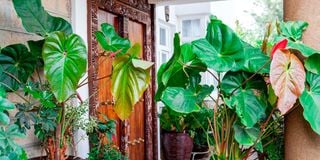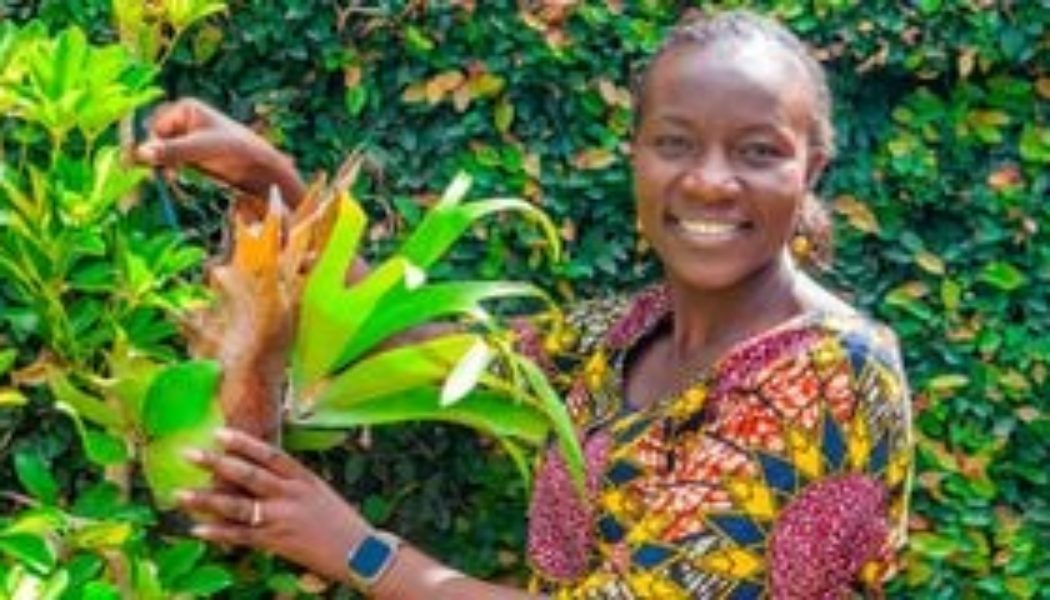Dorine Bolo’s front yard in Nairobi’s Karen is the most striking. All her neighbours have plants outside their homes, but hers shows some keenness in design.
She has grown the captivating crotons, eugenias with reddish leaves, the snowbush and the lime cypress, which bring a variety of colours.
“For my outside, I wanted some colour but didn’t want to go for blooming plants because they are harder to take care of. I was very intentional about how my garden will look,” says Dorine, who vowed not to have durantas as part of her fence. “I don’t like durantas, as they are very common. They are like the Kenyan uniform for every garden.”
The passion
Dorine has been in love with plants for the longest time.
“Gardening is my love language. Any space I can get, I think to myself, can I put a plant here? My mom used to work in a flower shop, so she would occasionally come home with roses and we’d put them in a vase. Growing up, we would also plant flowers in small buckets and re-purposed containers,” she says.

Dorine Bolo in her garden during the interview on June 22, 2024.
Photo credit: Billy Ogada | Nation Media Group
Before moving to her current house, she was a tenant, and, “even before we moved here, I had flowers in pots. I have always been surrounded by plants, even if it is the small succulents on a table,” the mother of two says.
In 2020, Dorine and her husband purchased a 1/8 acre piece of land in Karen where they built their forever home. To some, an eighth seems like a small space but for Dorine it was more than adequate to bring her dream garden to life.
Her trick: “I have kept many of my plants in pots and planted a few on the ground.” Now Dorine has over 100 potted flowers and trees.
Most of her plants are palms because they are easy to maintain and they will always look beautiful.
“I also like anthuriums because I can always cut them, put them in a vase and place them on my table,” she says.
Her backyard holds a spacious pergola [an outdoor garden feature forming a shaded walkway].
“This pergola was not here when we built the house. I had put some vegetables in this section but then I felt that we needed a chilling place. So we had the pergola built and we covered the whole area with turf grass. Since there is not much light getting into the pergola, I placed strong plants like the monsteras, philodendrons and some of my succulents,” she says.
When it comes to small spaces, most people choose the location of the house first, then create a garden out of the remaining space. But for Dorine, while the construction of their house went on, she ensured that they made room for a garden.
“We wanted to have functional spaces like a back area with ample space for cleaning and cooking when we have guests. I did not want to compromise on that. We gave room for the servants’ quarters and the parking area. What remained is now what has become my garden. I have very little space so I rely mostly on pots,” she says.
Now Dorine has potted plants growing on all three balconies in her house and her window sills.

A section of Dorine Bolo’s Garden with a variety of potted plants at her home in Nairobi Karen on June 22, 2024.
Photo credit: Billy Ogada | Nation Media Group
Sh1 million
But creating such a garden is not cheap, especially if it is a potted garden. But for Dorine, the reward of having her own green space exceeds the pinch it causes to her pocket.
“It is a very expensive endeavour but because I like gardening, I am always looking for deals, be it a flower fair, or a plant sale and there are even groups on Facebook where they sell plants at a cheaper price. I have spent close to Sh1 million on this garden, particularly on buying pots and plants. Some of these plants are very expensive. For instance, these cycads cost between Sh5,000 to Sh10,000 and I have eight of them,” the 40-year-old says.

Potted Anthurium plants at Dorine Bolo’s Garden in Nairobi Karen on June 22, 2024.
Photo credit: Billy Ogada | Nation Media Group
To ease the financial pinch, Dorine bought the pots a piece at a time and entered into credit agreements with her supplier.
“I was lucky to get a plant vendor who would give me the plants and pots on credit and I would pay for them at the end of the month. Now I no longer buy pots because I have too many of them and I don’t have space.”
Creating the garden
When the family moved to their Karen home, Dorine first planted Arabica grass. But she says she is going to uproot it and in its place plant Pemba grass which fills up the space and is always green.
“After the grass, I planted the trees. I had two rubber plants, a royal palm and a traveller’s palm that were in pots so I transferred them to the ground. The good thing is that we moved here during the Covid-19 period so we were working from home exclusively. In the evening, you would always find me planting. Every potted plant you see here in a pot I have planted,” the communication and development strategist tells the Business Daily.
When choosing where to place her pots, Dorine considers the needs of the plants and the location.
“For instance, in the washing bay, I know that people move there a lot so I place a plant that is resilient but can still highlight the beauty. On my front porch, I have my palms and cycads in pots. This is where my son often plays basketball with his friends,” she says.
With the garden all filled up, Dorine says she now does a lot of interchanging of the pots.
“I am always transferring the plants that are not doing well in pots. Sometimes they struggle because the pots constrain them. But sometimes that is a good thing because pots help maintain the size of a plant. So if I have a plant that is colonising the ground space, I transfer it to a pot,” Dorine says.

Dorine Bolo’s window sill where a variety of potted succulents grow during the interview on June 22, 2024.
Photo credit: Billy Ogada | Nation Media Group
This is how she has successfully controlled her fig tree’s growth.
“When I plant it on the ground, it will take up a big space which I don’t have,” she says showing us her blossoming rubber plants in large pots.
Potting and repotting of plants is often fraught with risks. Done incorrectly, a plant starts to gradually die. Dorine says you need to flood the pots with water. This way, when you are uprooting them, the roots do not break.
Taking care of the garden
Dorine cautions that potted plants require extra care.
“If you don’t take care of them well, they become stressed and start to suffer. I have to be keen to find out which plant is struggling and in which spot. This would then require me to change the position of the pot,” she says adding, “I have a gardener who comes twice a week to help with the pruning, moving of the pots and trimming of the grass. But most of the garden maintenance I do myself.”
Water is not an issue as the family has built two underground tanks to harvest rainwater, “One holds 100,000 litres of water while another holds 30,000 litres.”
Dorine’s garden has developed a system of sustaining itself and she says she rarely uses fertiliser.
“I do the initial planting with compost, then I do not need to use fertiliser again.”
Snails and caterpillars have been the source of her frustration as they, “attack the plants and poke holes. I do not want to use chemicals, so I mix dish-washing soap, water and vinegar, and then I spray,” she says.

A section of Dorine Bolo’s Garden in Nairobi Karen on June 22, 2024.
Photo credit: Billy Ogada | Nation Media Group
Taking care of the pots
Dorine has mastered the art of taking care of her pots. “I repaint them every year to ensure that they look neat. Some of the pots were white and maintaining them was not easy because they get dirty so I changed the colors to this mahogany.”
On buying the right pots Dorine advises that one should get well-molded pots that cannot break easily when the plants develop longer roots or when moving them.
While others rely on emotional support animals for comfort, gardening becomes an emotional outlet for Dorine.
“When I am stressed, I plant, when I am anxious I plant, when I am happy, I gift myself a plant,” she says.









